#human ecology foundation
Text
How the CIA backed research on mind control

David Dickson
March 15 1979
Nature Vol. 278
David Dickson reports on recent revelations about the Central Intelligence Agency's support for university research
In the late 1950s and early 1960s, the US Central Intelligence Agency mounted a comprehensive and well-planned effort to encourage university scientists to carry out research that would, the agency hoped, lead directly to techniques for controlling the human mind.
According to previously classified documents, the agency was responsible for initiating or supporting research that led subsequently to important contributions in various fields of behavioral science, including sociolinguistics, psychotherapy, and personality assessment.
And in an effort to legitimize its interest and obtain access to leading investigators, the agency financed a funding organization that provided grants to a number of prominent members of the scientific community including Carl Rogers, B. F. Skinner, and Professor Hans Eysenck even though the researchers were frequently unaware of the true source of their support.
The details of the CIA's involvement in these fields, described as helping to "liberate the behavioral sciences from the world of rats and cheese," are provided in a book which has just been published in the US by Mr. John Marks, a former Senate aide and State Department official. (The book will appear in the UK later this year.)
Using documents obtained through the Freedom of Information Act, Mr. Marks has put together a detailed picture of how the agency used the academic community in its search for the holy grail: a technique that would provide sufficient manipulation of the human mind to eliminate uncertainty from the intelligence business.
Many of the more bizarre, farcical, or outrageous aspects of this pursuit have since received wide publicity. These range from experiments that switched the East Coast academic community on to LSD, to the construction of a bugged San Francisco brothel (and included a scheme to make Fidel Castro's beard fall out).
But behind these there was, as Mr. Marks shows, a closely considered plan for deriving, through the extension of conventional research techniques and the often unknowing cooperation of university scientists, the type of information that the CIA could use for controlling the behavior of its agents and others.
Much of this research was financed through an organization known as the Society for the Investigation of Human Ecology, set up at Cornell University in 1955 under the guidance of Dr. Harry Wolff, professor of neurology and psychiatry, who was later to become president of the American Neurological Association.
Dr. Wolff's aim, which received considerable sympathy in various academic circles of the time, was to provide a framework for the multidisciplinary study of man in relation to his environment. The CIA's interest was sufficient for it to provide 90% of the society's funding until, having separated from Cornell in 1957 to obtain "more established stature in the research community," the organization was folded in the mid-1960s.
Some of the research funded through the society had a direct and obvious relation to the agency's interests. It provided Wolff himself with a research grant of $74,000 to study the factors that cause men to defect from their countries and cooperate with a foreign government. In other cases, the concerns were more basic. Professor Charles Osgood, for example, who had asked the CIA to support his research into the way people in different societies express similar feelings, received $192,975 over five years through the society. He later completed his influential work on cross-cultural meaning on a grant from the National Institute of Mental Health.
In some cases, the CIA used research grants explicitly to build up the prestige of the Human Ecology Society. Thus, the society provided $26,000 to Professor Eysenck of London University to support his work on motivation; the agency accepted that the research would have "no immediate relevance to agency needs", but the society took funding credit for nine of his publications in its 1963 report.
"It's news to me," said Professor Eysenck. Often the research workers were unaware of the source of the majority of the society's funds; some were told that the money came from rich New York doctors or Texas millionaires. "I don't like secret involvement of any kind. I can't see why it could not have been open and above board," says Professor B. F. Skinner, who received $5,000 towards the research leading to his book Freedom and Dignity.
But as well as providing academic respectability, funding of research through the society allowed the CIA legitimately to approach "anyone in the academic community", as one source put it. Thus, in a move that Mr Marks describes as "turning scholars into spies", the society provided $15,000 towards a tour of the Soviet Union by ten prominent psychologists (only one of whom knew of the agency's involvement), and CIA officials debriefed the group on its return.
Support for university behavioural research was curtailed in the mid-1960s. However, in contradiction of testimony later given to Senate committees, the research itself was continued, although with a greater emphasis on more direct ways of influencing behaviour, such as inserting electrodes in the brain. (At one point, agency scientists considered the potential of genetic manipulation: "The rest of the world didn't ask until 1976 the type of questions we were facing in 1965", one agency source is quoted as saying.)
Mr. Marks admits that much of the research which the CIA sponsored led to important contributions to accepted academic knowledge- possibly because the agency was free to take imaginative leaps denied to more conservative (or more democratic) agencies. But he is uncompromising in criticising the ethical basis under which many of the experiments were carried out. (This was not always the agency's fault; some scientists had to be restrained from taking their experiments on, for example, sensory deprivation to their "terminal" conclusion.)
"We as a country can defend ourselves without sending our own scientists--mad or otherwise-into a hidden war that violates our basic ethical and constitutional principles. The time has come for the United States to lead by example by voluntarily renouncing secret government behavioural research," Mr Marks writes in his conclusion.
#mind control#brainwashing#cia#mkultra#counterinsurgency#john marks#parapolitical#parapolitics#lsd#human ecology fund#human ecology foundation
0 notes
Text
how many times can you live through the apocalypse?
when you were little there was this beach that was free to go to. you didn't really like it on account of the litter. at one point, a white bag caught around your ankle, and for a moment (fish child), you panicked about jellyfish. on the foam, the red-pink words read thank you, stacked on top of each other, tangled in the kelp.
they have a new program (three thousand american dollars) to send your dead relative to the moon. there is a lot of evidence that our local orbit is becoming ever-more dangerously populated with "micro" satellites - debris in a round miasma becoming a thick web above us. maybe angels cannot hear us through the pollution.
you used to picture deep space like a thick membrane, or a blanket. someone said to you once the universe has no edge and that fucked with you for a long time, trying to picture what shape infinity has. your coworker is writing a short story about ecological collapse, which she is submitting for a little side-money so she can survive the current economical collapse.
the birds haven't gone to sleep this winter. that is probably bad. something that actually freaks you out is the natural temperature of human bodies versus the survival temperature of certain fungi. there is a podcast called s-town, in which a man kills himself over climate anxiety. he was probably meant to seem sort of unhinged. it just seems like it is becoming increasingly clear he was being honest.
space is not empty, we have put our dead into the stars. at some point they will figure out how to put ads into our sleep. you need to pay for the greenlife subscription service to be able to save the world.
there is a lot of ways this poem ends. but you have been wearing the same jeans and shirts since you were, like, 18. it is a hard life, sometimes, watching the entire foundation crack. there was this one moment over the summer, where you were shaking with heat exhaustion and dehydration. you were offered a nestle water bottle.
for three thousand dollars, you can send your ashes into space.
instead, you wash out the peanut butter jar. you put the avocado-toothpick spiked seed ball into water (even though they never grow very far). you borrow what you do not want to buy. you pick up any litter you find. you do not have a lot of control, really. but where you do - if there is one thing you can do, you do it.
something about that. you need to believe that must be true for the rest of humanity. or maybe - you need to believe that to be true, or else there will not be a rest of humanity.
#writeblr#spilled ink#i hope it is clear in this that i wholeheartedly believe the problem is capitalism and not individuals
3K notes
·
View notes
Text
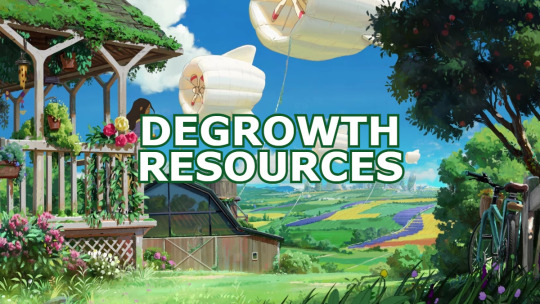
Degrowth basics
"The word degrowth stands for a family of political-economic approaches that, in the face of today’s accelerating planetary ecological crisis, reject unlimited, exponential economic growth as the definition of human progress."
What is Degrowth? | Caracol DSA
Why degrowth is the only responsible way forward | OpenDemocracy
Degrowth and MMT: A thought experiment
We Need A Fair Way To End Infinite Growth | Current Affairs
Degrowth: A Call for Radical Abundance | Common Dreams
Can degrowth save us and the planet? | Nottingham Trent
Defending limits is not Malthusian | Undisciplined Environments
Can We Have Prosperity Without Growth? | New Yorker
The Urgent Case for Shrinking the Economy | The New Republic
Giving Up on Economic Growth Could Make Us Cooler and Happier | The New Republic
A guide to degrowth: The movement prioritizing wellbeing in a bid to avoid climate cataclysm | CNBC
What is ‘degrowth’ and how can it fight climate change? | Popular Science
Enough for Everyone | Yes! Magazine
Toward a Post-Capitalist Future: On the Growth of “Degrowth” | Lit Hub
All we are saying is give degrowth a chance | The RSA
A pathway out of environmental collapse | newsroom
On Technology and Degrowth | Monthly Review
What is degrowth (and more importantly, what is it not)? | META
Green growth
"There is no empirical evidence that absolute decoupling from resource use can be achieved on a global scale against a background of continued economic growth."
Is Green Growth Possible? | Jason Hickel & Giorgos Kallis
The Myth of America’s Green Growth | Foreign Policy
The decoupling delusion: rethinking growth and sustainability | The Conversation
Is green growth happening? | Uneven Earth
Green Growth | Uneven Earth
The Delusion of Infinite Economic Growth | Scientific American
Degrowth is not austerity – it is actually just the opposite | Al Jazeera
A response to Paul Krugman: Growth is not as green as you might think | Timothée Parrique
Deceitful Decoupling: Misconceptions of a Persistent Myth | Alevgul H. Sorman
Degrowth isn’t the same as a recession – it’s an alternative to growing the economy forever | The Conversation
Degrowth and the left
"In the middle of an ecological emergency, should we be producing sport utility vehicles and mansions? Should we be diverting energy to support the obscene consumption and accumulation of the ruling class?"
The Left should embrace degrowth | New Internationalist
Ecosocialism is the Horizon, Degrowth is the Way | The Trouble
Degrowth: Socialism without Growth | Brave New Europe
Toward an Ecosocialist Degrowth: From the Materially Inevitable to the Socially Desirable | Monthly Review
For an Ecosocialist Degrowth | Monthly Review
Degrowth and Revolutionary Organizing | Rosa Luxemburg NYC
The necessity of ecosocialist degrowth | Rupture
Degrowth is Anti-Capitalist | Protean Mag
Degrowth Communism | PPPR (Part one | Part two | Part three)
Economic Planning and Degrowth: How Socialism Survives the 21st Century | New Socialist
Degrowth and the South
"Southern countries should be free to organize their resources and labor around meeting human needs rather than around servicing Northern growth."
Who is afraid of degrowth? A Global South economic perspective | IBON Foundation
The anti-colonial politics of degrowth | Jason Hickel
Unlearning: From Degrowth to Decolonization | Rosa Luxemburg NYC
Degrowth requires the Global South to default on its foreign debts | Resilience
Journals/Reports
Degrowth: a theory of radical abundance | Jason Hickel
A systematic review of the evidence on decoupling of GDP, resource use and GHG emissions, part II: synthesizing the insights
What does degrowth mean? A few points of clarification | Jason Hickel
Providing decent living with minimum energy: A global scenario | Global Environmental Change
Urgent need for post-growth climate mitigation scenarios | Nature Energy
Degrowth and critical agrarian studies | Julien-François Gerber
Decoupling debunked – Evidence and arguments against green growth as a sole strategy for sustainability | European Environmental Bureau
Incrementum ad Absurdum: Global Growth, Inequality and Poverty Eradication in a Carbon-Constrained World | David Woodward
Degrowth can work — here’s how science can help | Nature
A New Political Economy for a Healthy Planet | Jason Hickel
Planning beyond growth. The case for economic democracy within limits
Millionaire spending incompatible with 1.5 °C ambitions | Cleaner Production Letters
Is green growth happening? An empirical analysis of achieved versus Paris-compliant CO2–GDP decoupling in high-income countries | The Lancet
Books
Exploring Degrowth: A Critical Guide | Pluto Press
A People's Green New Deal | Max Ajl
Less is More: How Degrowth Will Save the World | Jason Hickel
Breaking Things at Work: The Luddites Are Right About Why You Hate Your Job | Verso Books
The Future is Degrowth: A Guide to a World Beyond Capitalism | Verso Books
The Imperial Mode of Living: Everyday Life and the Ecological Crisis of Capitalism | Verso Books
Marx in the Anthropocene: Towards the Idea of Degrowth Communism | Kohei Saito
Degrowth & Strategy: how to bring about social-ecological transformation
27 Essays and Thoughts on Degrowth | Giorgos Kallis
Videos
Yes To Limits To Growth! | The Other School
How Degrowth Can Save the World | Andrewism
How We End Consumerism | Our Changing Climate
Demystifying Degrowth | Rosa Luxemburg NYC
Degrowth is not Austerity | John the Duncan
Degrowth and Ecosocialism | Planet: Critical
Degrowth in 7 minutes: Fighting for climate by living better | Think That Through
The Future is Degrowth (w/ Aaron Vansintjan) || SRSLY WRONG
"Degrowth means power to the working class!"with Jason Hickel | GND Media
Others
degrowth.info
Degrowth Journal
Doughnut Economics

2K notes
·
View notes
Text
Indigenous genocide and removal from land and enslavement are prerequisites for power becoming operationalized in premodernity, a way in which subjects get (what Wynter names) “selected” or “dysselected” from geography and coded into colonial possession through dispossession. The color line of the colonized was not merely a consequence of these structures of colonial power or a marginal effect of those structures; it was/is a means to operationalize extraction (therefore race should be considered as foundational rather than as periphery to the production of those structures and of global space). Richard Eden, in the popular 1555 publication Decades of the New World, compares the people of the “New World” to a blank piece of “white paper” on which you can “paynte and wryte” whatever you wish. “The Preface to the Reader” describes the people of these lands as inanimate objects, blank slates [...]. [Basically, "Man" is white, while nonwhite people are reduced an aspect of the landscape, a resource.] Wynter suggests that we [...] consider 1452 as the beginning of the New World, as African slaves are put to work on the first plantations on the Portuguese island of Madeira, initiating the “sugar–slave” complex - a massive replantation of ecologies and forced relocation of people [...]. Wynter argues that the invention of the figure of Man in 1492 as the Portuguese travel to the Americas instigates at the same time “a refiguring of humanness” in the idea of race. This refiguring of slaves trafficked to gold mines is borne into the language of the inhuman [...].
---
The natal moment of the 1800 Industrial Revolution, [...] [apparently] locates Anthropocene origination in [...] the "new" metabolisms of technology and matter enabled by the combination of fossil fuels, new engines, and the world as market. [...] The racialization of epistemologies of life and nonlife is important to note here [...]. While [this industrialization] [...] undoubtedly transformed the atmosphere with [...] coal [in the nineteenth century], the creation of another kind of weather had already established its salient forms in the mine and on the plantation. Paying attention to the prehistory of capital and its bodily labor, both within coal cultures and on plantations that literally put “sugar in the bowl” (as Nina Simone sings) [...]. The new modes of material accumulation and production in the Industrial Revolution are relational to and dependent on their preproductive forms in slavery [...].
---
Catherine Hall’s project Legacies of British Slave-Ownership makes visible the complicity in terms of structures of slavery and industrialization that organized in advance the categories of dispossession that are already in play and historically constitute the terms of racialized encounter of the Anthropocene. In 1833, Parliament finally abolished slavery in the British Caribbean, and the taxpayer payout of £20 million in “compensation” [paid by the government to slave owners] built the material, geophysical (railways, mines, factories), and imperial infrastructures of Britain and its colonial enterprises and empire. As the project empirically demonstrates, these legacies of colonial slavery continue to shape contemporary Britain. A significant proportion of funds were invested in the railway system connecting London and Birmingham (home of cotton production and [...] manufacturing for plantations), Cambridge and Oxford, and Wales and the Midlands (for coal). Insurance companies flourished and investments were made in the Great Western Cotton Company, for example, and in cotton brokers, as well as in big colonial land companies in Canada (Canada Land Company) and Australia (Van Diemen’s Land Company) and a number of colonial brokers. Investments were made in the development of metal and mineralogical technologies [...].
The slave–sugar–coal nexus both substantially enriched Britain and made it possible for it to transition into a colonial industrialized power [...]. The slave trade [...] fashioned the economic conditions (and institutions, such as the insurance and finance industries) for industrialization. Slavery and industrialization were tied by the various afterlives of slavery in the form of indentured and carceral labor that continued to enrich new emergent industrial powers from both the Caribbean plantations and the antebellum South. Enslaved “free” African Americans predominately mined coal in the corporate use of black power or the new “industrial slavery,” [...].
---
The labor of the coffee - the carceral penance of the rock pile, “breaking rocks out here and keeping on the chain gang” (Nina Simone, Work Song, 1966), laying iron on the railroads - is the carceral future mobilized at plantation’s end (or the “nonevent” of emancipation). [...]
[T]he racial circumscription of slavery predates and prepares the material ground for Europe and the Americas in terms of both nation and empire building - and continues to sustain it.
---
All text above by: Kathryn Yusoff. "White Utopia/Black Inferno: Life on a Geologic Spike". e-flux Journal Issue #97. February 2019. [Bold emphasis and some paragraph breaks/contractions added by me. Text within brackets added by me for clarity. Presented here for commentary, teaching, criticism purposes.]
101 notes
·
View notes
Text





the africana studies students
a multidisciplinary approach, combining politics and ecology, history and economics
learning about everything from precolonial african nations to the roots of the civil rights movement in the americas
tracing the african diaspora across oceans and through continents
reading foundational works by W. E. B. Du Bois and Carter Woodson
examining race and anti-Blackness on a global scale
a strong sense of self, knowing who you are and where you came from
understanding the power of identity
a haphazard pile of textbooks and paperbacks
a passion for activism that transcends and informs your studies
learning sociological methods to examine the world around you
using what you learn in class to inform your view on world events
challenging eurocentric tellings of history
an overflowing bookbag, complete with your favorite pens and highlighters
colorful textiles, skillfully woven
spotting loan words from yoruba or swahili in your own language
imagining humanity's roots in the home of our most ancient ancestors
a stack of bright post-its to color-code your notes
fighting for the restoration of stolen artifacts
deconstructing the colonial past to better understand the present
finding connections through history and across fields
#student aesthetic#studying aesthetic#studyblr#studyspo#dark academia#dark acadamia aesthetic#academia#academia aesthetic
40 notes
·
View notes
Text
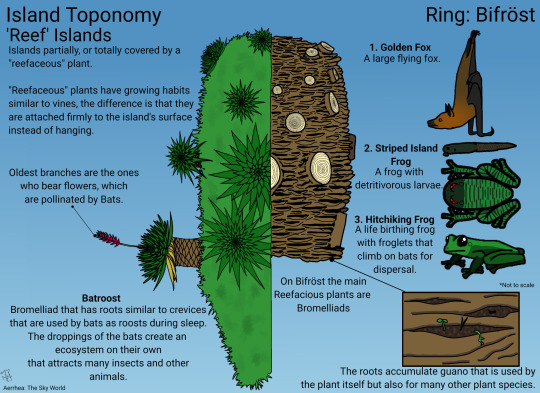
Island Toponomy
Ring: Bifröst
'Reef' Islands
'Reef' Islands are islands totally or mostly covered by "Reefaceous" or Reef-building plants, who here in Bifröst are Bromeliads.
These plants tend to be the foundation for other plants, gathering substrate for later species such as grasses, trees, etc. But also literal footing for animals not only moving from island to island but as in roosts or places to hide in. Thus they are called reefaceous/reef-builders, due to their ability to house in an ecosystem on their own within their roots.
Not all (in fact only a few) islands are completely reefaceous in nature as these kinds of plants tend to come later in the ecological succession of islands, competing fiercely with the wind-dispersed vines.
Individual Species Description
Batroost Creparophora insulobnubens (Crevice-Bearing Island-Coverer)
This plant is the type genus for not only its family but for Reef-building plants from Bifröst in general.
This plant starts out as a small, vividly colored, sweet fruit that is then consumed by animals such as bats, monkeys, goats and humans. Then carried within their stomachs to other islands where the small, hardy seeds contained within the droppings will hopefully get a strong footing to start growing many branches during its life. That is, in between the roots of other plants, including other Batroosts.
The plant itself starts to grow faster than trees but slower than the quick-growing vines, but fast enough to get a good grip on the surface of the island. Then, growing slowly over the years they spread across the island with their 'cracked' roots, collecting detritus and doing their namesake -serving as the roosts for bats.
Bats are definitely the most notorious of the daily users of this plant, using the roots to hang themselves upside down while covered by the many vines that grow over, and among the roots of the Batroost.
This is the case for the Golden Fox (Pteropus vulgaris Meaning "Common Foot Wing") which is a large, frugivorous bat from the same genus as the Flying Foxes from Earth, hence the "fox" in their name. The Golden Fox is a common (though not the only) dweller and user of these plants as roost. They not only benefits from the plant but the Batroosts also benefits from the bats, not only from the aforementioned nutrients found in their droppings (guano) but also to spread the seeds of the plant, as the fruit is a favorite meal of the bat.
However they are not the only animals to use this bromeliad, in fact many animals live their whole lives -or at least part of it- among the twisting crevices of the plant.
The Striped Island Frog (Vermigyrinus spp meaning "Worm Tadpole") is such an animal that lives part of its life among the roots of the Batroost. Although the adults live close by, hunting for insects and small vertebrates among the vines and trees, the larvae have a very specific niche. They don't necessarily need water to survive because they live in the concentrations of guano and decaying matter that accumulates in the crevices of the roots, a niche that is somewhat lacking in Aerrhea for one reason: There are no worms in this world. For whatever reason there are not annelids in Aerrhea (or at least in Bifröst) to live in and eat the humus of the shallow soil of islands, thus these frogs took this golden opportunity and exploited it. The Crevice micro-ecosystem is a well protected one and not explored by many as it is covered by thousands of vines, blocking the view of large predators and also their passage, offering a calm existence in these "pockets of nutrients" as far as "calm" can go in a constantly moving habitat. Which is also another pro for such a lifestyle as this is both a relatively competition-free ecosystem with many nutrients to consume.
The long tadpole can live for two weeks on their personal "terrariums" before metamorphosing into adults, climbing out of the roots' area and never returning again, at least that is the case for the males as the females after copulation (this species has internal fertilization) return to the crevices to lay 1-3 eggs -depending on the size of the crack and available detritus-, each on a different crevice to avoid competition among the larva and then leave them on their own until they grow into frogs and the cycle repeats again.
An example of an animal that lives its "whole" life among the nooks and crannies of the dark, understory is the Hitchhiking Frog (Viatoribus spp meaning "Passenger") who gets its name from its habits early in life. This tiny little frog also has internal fertilization, but instead of laying eggs they give birth to developed froglets whose voyage starts not long after being brought into this world. The mother frog, who lives by the crevices eating small invertebrates such as ants, climb upon roosting bats and give birth to their small versions of themselves, who using two opposing fingers grab onto the fur of their hosts and wait until they set flight again. This strategy is used due to the small size and vulnerability of these frogs, who use the larger bats as means of dispersing into other islands, giving a higher genetic diversity to these small ingenuous frogs.
#aerrhea#my art#worldbuilding#art#illustration#spec bio#speculative biology#spec evo#speculative evolution#speculative zoology#fantasy#speculative ecology#speculative worldbuilding#speculative botany
41 notes
·
View notes
Text
(Some of) The Achievements of Dr. Ratio
And Elaborations on Their Significance: A Review
As transcribed from the Keeping Up with Star Rail video because that shit was hard to read
Medicine: Developed serum for lithogenesis, completely lifting the shadow of the "King of Diseases"
Philosophy: Published What is Knowledge, acclaimed as the "ultimate answer to all 'epistemological' questions."
Natural Theology: Published the work Aeons: A Natural Phenomenon, hailed as the "most sacred prophet of Aeon non-theism."
Mathematics: Published a paper entitled "A Solution to the Marta-Cishian Undirected Connectivity Problem in Metric Spaces," successfully solving three of the "Seven Challenges in Contemporary Mathematics" left by Genius Society #56, Elias Salas.
Physics: Established the Ratio Unified Field Theory, thoroughly elucidating the spaciotemporal discrete structure that was once obscure to humanity.
Computer Science: Published a paper entitled "Existence Proof of the Fyangu Function," opening the doors to solving numerous problems in computer science.
Engineering: Led the research on the Energy Black-Body Radiation Generator, resolving the energy crisis of the century (multiple Amber Eras).
Biology: Published papers on "The Neurobiological Mechanisms of the Nesting Behavior of Witherflies" and "The Metabolism of the Ahriman Archaea." As Genius Society member #55 Yu Qingtu once said, these two papers "accelerated the scientific world's understanding of species evolution by 1000 years."
This sounds like a load of honky, right? Yeah. So let's break it down and address what we can here. Keep in mind that while I am a biologist (officially, in five months) and intimately familiar with evolution and ecology, I know Very Fucking Little about everything else! I am looking into sources while I go through this.
So, the first thing: what is lithogenesis?
Looking into the breakdown of the word, we can split it into its prefix particle and the suffix particle: 'litho' and 'genesis'. The prefix 'litho-' refers to stones, such as in lithiasis, which is the pathological creation of stones (like kidney stones) in the body. -genesis refers, obviously, to the beginning, development, or production of something, such as in osteogenesis, the production of bone. But if lithiasis already exists, then what might lithogenesis mean? Given that it is referred to as the King of Diseases (which is another interesting note), my guess is that it is perhaps a more literal version of scleroderma (an autoimmune disease that causes the skin to thicken and harden), where the skin or other parts of the body literally turns to stone. This is significant for another reason, which is that Ratio is Greek (as well as Roman, but we'll get into the points of his character design with another post). Some of the most famous monsters of Greek mythology are the Gorgons, of which Medusa is the most notorious. What did the Gorgons do? Turn people to stone. I'd like to propose that lithogenesis is perhaps a degenerative disease that previously had no cure in which the body undergoes accelerated petrification caused by a creature not dissimilar to the Gorgon, though I hesitate to suggest that the disease is as fast acting as the Gorgons' stare is.
Second: What is Knowledge and epistemology
I don't have much to say about this one as I am not well versed in philosophy, but a quick google search says that epistemology is "the theory of knowledge, especially with regard to its methods, validity, and scope. Epistemology is the investigation of what distinguishes justified belief from opinion." AKA: What do people know, and how do they know what they know? Further digging says that epistemological debates revolve around four main areas: 1) the analysis of the nature of knowledge, as well as the conditions for belief to constitute as knowledge (truth, reason); 2) sources of knowledge or belief (memory, reason, perception, testimony); 3) the structure of knowledge or belief (foundations of belief vs. coherent justification); 4) skepticism, which basically questions all of that, and the implications for such skepticism. I found this to be neat because this is Ratio's fundamental approach to teaching, and I just thought that was fun. Epistemology has been debated since ancient Greek philosophy, and that tie-in to his entire character was nice.
Third: Aeon non-theism
Now this was real fun to see, and I ended up laughing about it to some friends because from the outside, it looks like Nous' rejection of Ratio left him so petty he became an atheist, and perhaps that is true, but it holds far more significance to his character than that. The Aeons, all of them, are higher-dimensional entities widely worshiped as gods by all sorts of people across the galaxies (also called Gods of the Stars in Chinese), and even the Genius Society treat Nous as a god with more than some level of fanaticism. The Aeons are prayed to, sworn by, given offerings, and bless followers with their powers. It's not hard to see why they are considered gods. Yet Dr. Ratio basically challenges that with a reference to the Aeons as natural phenomena, rather than divine beings. The idea of natural theology in general is interesting, and I guess it has to do with the fact that the Aeons, while perceived as gods, do have direct and tangible impacts and effects on the natural world. I imagine that Dr. Ratio argues that Aeons are the product of an entity (or multiple) embodying a belief, movement, or philosophy to its utter and exhaustive extreme, and that what makes a god is whether or not they are perceived as worthy of worship, yet every single thing in the universe is subject to scrutiny and criticism. Worship introduces blindness, tunnel vision, fanaticism, and ignorance, and erases scrutiny and reason. It is as he says: "the Path of Erudition has neither reason nor logic." As Ratio scrutinizes all things, he therefore worships nothing, thus directly challenging the widespread worship of not just the Aeons, but those they favor and choose to represent them (hi Genius Society ;) ).
Fourth: ....Math.
Again, not much to say here (I don't even know if the problems addressed are mentioned in-game as readables, but I might do some digging tomorrow to find out) but I find it especially significant to point out that he solved problems that even Elias Salas, one of the most famous Genius Society members, did not (or left behind). I need to stress that Ratio is a genius. He is. What gatekeeps him from the Genius Society is not capability, but principle. Elias Salas (along with #22, Aiden) is incredibly unique among the Genius Society members for being someone who actively shared his findings and inventions with the public, handing the rights to the Synesthesia Beacon as well as long-range communications technology to the Intelligentsia Guild. But Ratio's focus is less on the pursuit and breakthrough of uncharted knowledge and more on the sharing and use of knowledge to educate and help others. Though he's certainly made breakthroughs himself, it's clear he does so with the intent of bettering lives, not just because he can. Maybe one could argue that he isn't "genius enough," but really? I just think that he cares too much. This point just goes to show that he is on par with the Geniuses of the Society, and that the existence of said Society introduces elitism into the picture more than the word already does -- hence Ratio's repeated use of the phrase "ivory tower."
Five: ...Physics.
So I did end up looking into unified theories for a more comprehensive understanding of what the fuck was so significant, and this is... admittedly far beyond the scope of anything I comprehend (obviously). But from what I could understand of current theoretical physics is that the unified theory is a goal of modern physicists, some single theory that can be used to marry the concepts of electromagnetism and gravity, as they're currently under two separate theories with no relation to one another. There is no singular, widely agreed upon theory as of right now, while the String Theory (vibrations of one-dimensional "strings" determine the properties of these strings, and each vibrational state corresponds to a particle) is one such attempt to do so it is not without its many criticisms. The idea of a unified theory was one that Einstein himself had tried, even on his deathbed, to formulate, but never managed to solve. It's been almost 70 years since then in our time, yet we can assume from the wording of the achievements that a unified theory that concisely joined forces (gravity) with fields (electromagnetism) was not proposed until Dr. Ratio, or at least was not improved until he posited his theory.
...In normal English: that's fucking huge. Truly, I wish I had more insight into the topic so that I could explain its applications, but I don't. Maybe this will be something I can return to later? I dunno. I'm not a quantum physicist adslkfjhsad
Six: ...Computer Science.
Okay this one actually genuinely holds no substance that I can write about aside from wow did you know Dr. Ratio is a polymath and super smart and cool and-
Seven: Energy crisis and black-body radiation
Back to the interesting things! So, to put it simply, black-body radiation refers to the light (electromagnetic radiation) a black-body emits when it is heated, as higher temperatures mean higher velocity of the charged particles on the surface of the black-body. The thing is that a black-body in the true sense is only a idealized object, not a realized one -- though black holes are predicted to get pretty close as they absorb almost all radiation rather than reflect it. After doing some reading, the reason this is so significant is that most real-world objects are not black-bodies, and thus only radiate a fraction of the energy that they theoretically would if they were black-bodies. Stars and planets are approximated as black-bodies when estimating their surface temperature, so... My guess is that Dr. Ratio was able to manufacture a material as close to a black-body as he possibly could, or discovered a celestial black-body that he could harness the radiation of, and engineered a generator that could use that power as efficiently as possible -- utilizing an isolated vacuum, the amount of radiated energy lost to gas particles or escaping the system would be reduced or near-entirely eliminated, thus providing far more energy than any systems or generators applied today.
Eight: Neurobiology and metabolism.
Now this is more my speed. The relation of neurobiological activity to cognition and behavior is actually specifically my major, but admittedly there is not much I can discuss without a mode of comparison. What are witherflies? What are they related to? How does their nesting behavior differ from that of other species related to them, and why is that significant for the understanding of cognition or their evolution? I could talk at length about sexual selection and intrasexual competition, about wars of attrition and the handicap hypothesis, but without something to compare to it's a bit of a moot point, especially since none of these nesting behaviors are described. Nesting is also very different from courtship, while both can (and do) affect the neurobiology (and physiology!) of both male and female individuals of a species, how and when they do so differs between each scenario. The metabolism of the Ahriman Archaea is an entirely different look into organisms which I find interesting for a different reason: archaea are single-celled organisms that, unlike bacteria, have genes (like us!) and unlike us are capable of utilizing far more energy sources than just organic compounds, such as metal ions or even hydrogen gas. Dr. Ratio's discoveries about the metabolism(s) of the species within the Ahriman Archaea could very well have provided immense insight into the evolution of life in that ecosystem, or whether or not said life can be traced to another galaxy or another point of origin. Another thing that I do want to point to here is the fact that he was acknowledged and praised by Yu Qingtu, someone that Ruan Mei mentions and I believe she considered a friend, or at least someone worthy of admiration.
TLDR: Dr. Ratio is absolutely a big deal and his spite towards the Genius Society is entirely justified, fuck you Screwllum.
#Willow Rambles#//about; (DOCTOR OF TRUTH)#i thought this would be longer than my piece on jy's relation to the aeons but i'm about 150 words short of that one#still sfdlgkjhadslfkjha#THIS TOOK SOOOO LONG
44 notes
·
View notes
Text
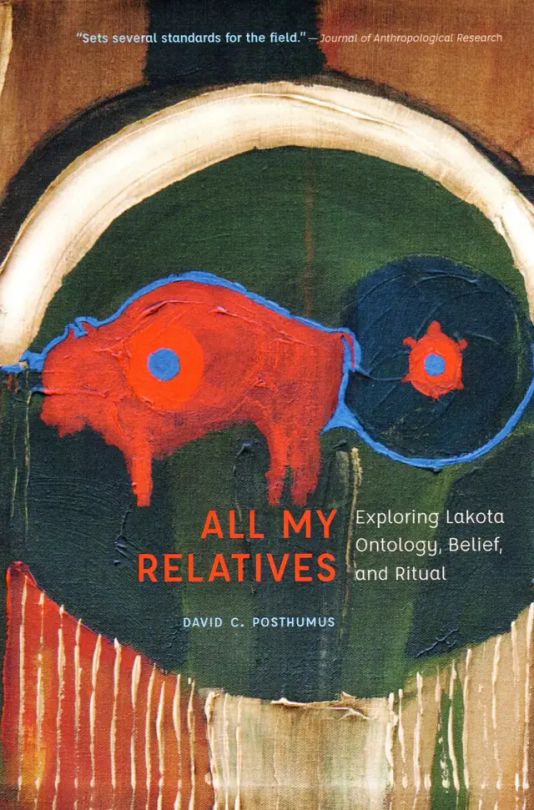

All my relatives: Exploring Lakota ontology, belief, and ritual. Posthumus DC (2022)
This is a book all about Lakota traditional beliefs and therefore has a lot of information connected to Mitakuye Oyasin. “At the heart of both Lakota religious continuity and innovation is an underlying animist ontological orientation, a basic way of seeing, understanding, and being in the world that extends personhood— in the form of a soul or spirit— to nonhuman life- forms.” This is expressed with ‘Mitakuye Oyasin’ –meaning ‘all my relatives’ or ‘we are all related’, which refers not only to human kinship but also to the relationship shared by all life-forms, both human and nonhuman, and the reciprocal obligations, responsibilities, and mutual respect that naturally extend from it” (14).
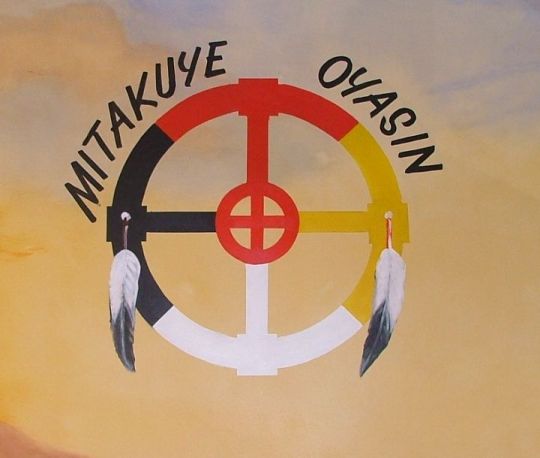
This repeats much of the ideas from similar definitions: belief in the connection between all life, relationships, the power the phrase has. It also gives a lot of words to help define these beliefs in academic language. Another important thing to point out is the way mitakuye oyasin is recognized as being part of Lakota innovation; my goal here is to use mitakuye oyasin to an innovation of queer ecology–hopefully add to the conversation.
“The normative cultural values encompassed by mitákuye oyásʾį are the very foundation of kinship, relational ontology, and the overarching interspecies collective, of which humans are only one hoop, one oyáte ‘people, nation, tribe’, in the company of many others. The key constituents of this animist ontology and worldview, of mitákuye oyásʾį, are persons, a category that extends beyond human beings to nonhuman or other- than- human persons. [...] Importantly, the Lakota worldview sees humans as the least knowledgeable and powerful beings, requiring the most aid and pity, upending the common Western biblical assumption that humans have dominion to rule over all other life- forms and subdue the earth (see V. Deloria 1999, 50; 2009, 99– 100). For the Lakotas, the seed of all life is wakʿą ‘sacrality, mystery, divinity’; ́ hence all life- forms share a generalized interiority, whether human or nonhuman.”

This is important information to support my argument. Queer ecology is very critical of Western beliefs and dichotomies that separate humans from nature and thereby present mankind as the ultimate lifeform (anthropocentrism). There are many essays and articles that examine the influence Christianity has had on the colonialist project (Gaard is the first that comes to mind). The Lakota worldview of being the ‘younger siblings’ of creation are supported by science in that ‘humans’ as a 'species' haven’t existed all that long in comparison to other 'species' and like many indigenous cultures, Lakota people knew the key to knowing nature was to learn from the world around us, as the author later confirms:
“Deloria explains that “the oldest traditions say that humans learned politeness and courtesy from the animals. . . . Generations of elders had already observed the behavior of birds . . . and decided that emulating them was the proper way for humans to act” (V. Deloria 2009, 123). Standing Bear (2006a, 56) substantiates this, writing, “The Lakota enjoyed his association with the animal world. For centuries he derived nothing but good from animal creatures. From them were learned lessons in industry, fidelity, and many virtues and much knowledge.” (50-51)
In the author’s footnotes is Vine Deloria’s examination of mitakuye oyasin that is, I feel, a great support of my claim:
“Vine Deloria refers to mitákuye oyásʾį as the ‘Indian principle of interpretation/observation,’ calling it “a practical methodological tool for investigating the natural world and drawing conclusions about it that can serve as guides for understanding nature and living comfortably within it. . . . We observe the natural world by looking for relationships between various things in it. . . . This concept is simply the relativity concept as applied to a universe that people experience as alive and not as dead or inert” (1999, 34). (Posthumus 2022 p219 f)
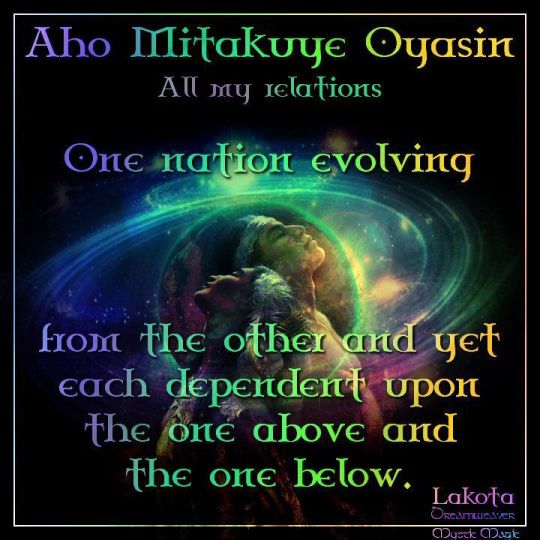
Queer ecology’s goal in many ways is to critique the ways the Western scientific paradigm has created inequity. Many are seemingly searching for solutions and answers to the problems that have been perpetuated by the colonial empire, supported as it is by western science.
While we must always, always be careful of appropriation and misappropriation–I contend that the solutions are not ones that need to be ‘discovered’ or solved in the way that Western science is so often searching for–advancement, the future…but rather, the answers are in what has always been there…and it’s simply a matter of observation.

#queer ecology#mitakuye oyasin#queer theory#ecofeminism#critical ecology#colonialism#all my relatives#lakota#indigenous studies#postcolonial theory#ecology#science#traditional ecological knowledge#queering ecology#ecosystems#environment#social ecology#long post
23 notes
·
View notes
Text

Deep Ecology and Eco Anarchism- A dialogue
“The more clearly we can focus our attention on the wonders and realities of the universe about us, the less taste we shall have for destruction.”
― Rachel Carson
The ecological security of the world we live in today has been all but completely compromised. Unrestrained human activity has insidiously undermined ecological processes and induced catastrophic outcomes which we now see manifesting in a multitude of forms, including severe environmental degradation, climate change, species extinction etc. Consequently, the dire disposition of the aforementioned circumstances have spawned a counter culture, who foster a deepening sense of discomfit and foreboding towards the extant industrial systems of production. It is from within this incipient nucleus of ecological anxiety, which engaged in a rebellion against the larger structures, that the ideologies of deep ecology, eco-anarchism and their ilk have emerged in the latter half of the 20th Century. Ecology, which by then was maturing rapidly as a field of inquiry during this period, provided the world with a new vocabulary to express the emergent concerns.
Touted as an ‘ecosophy’[1], Deep Ecology is claimed to have its roots in the direct experience of scientist-ecologists studying biodiversity and wildlife ecosystems out in the field. The corpus of literature detailing the ideological foundations of Deep Ecology derives from a myriad of sources, both popular and arcane, which include strains from romanticism, Eastern mysticism, indigenous knowledge systems and general ecological science. The elementary principles of Deep Ecology include the acknowledgement of the interrelatedness of all life, the ascription of a biotic equality to every living organism and an explicit rejection of anthropocentrism[2]. However, adherents like George Sessions claim that Deep Ecology is not an ideological construct but, is on the contrary a comprehensive understanding of the processes and workings of nature, without the imposition of any sort of ideologies on it.
Considering its conception of the human race as subordinate to nature- as a small and dispensable blip in the larger scheme of things, and its trenchant criticism of the egregious display of human hubris which seeks to manipulate all of nature to realize human ends, it is understandable that Deep Ecology continues to captivate and engage a passionate following. Through advocating a humbling of human ambition and by displacing humans from the focal point, Deep Ecology propounds a transcendalist worldview which situates non-human life at the centre of the discourse. Therefore, it should come as no surprise that a considerable number of conservationist movements from across the world arose from a Deep Ecological consciousness. However, for all its tidings on a holistic understanding of natural processes and their indispensability, Deep Ecology continues to be inexorably mired in ideology.
For starters, Deep Ecology, while ostensibly rejecting anthropocentrism and ideological leanings, overlooks the fact that the imposition of any human symbolic discourse on nature becomes innately anthropocentric. Further, Deep Ecologists like George Sessions assert that all life forms have an equal ‘right’ to live and blossom. Here, too they are inadvertently resorting to anthropocentrism by projecting human socio-political categories, specifically, legalistic and bourgeois-humanist ones like abstract legal rights, onto nature.
Further, they equate the technocratic exploitation of nature and the utilitarian reductionism of its components into resources as an irredeemable consequence of the biological need of an over populous human species. There is an overt endorsement of the outdated Malthusian notions on overpopulation, while advancing such an argument. In truth, the assumption that the destruction of nature brought about by a post capitalist society is actually the outcome of our biological destiny, is quite absurd. By doing this, Deep Ecologists are only mistakenly conceiving of capitalism’s affinity for chronic rapacity as something inherent to human kind. In a glaring oversight, they fail to acknowledge that benignant human cultures whose interactions with nature were intrinsically sustainable, had existed throughout human history.
In addition, Deep Ecologists, who almost invariably belong to countries from the global North, have also been known to recourse to Social Darwinism to berate third world countries for their backwardness. They extend this formulation to advocate, quite unapologetically at times, the genocide of these ‘others’ to help revert human population to, supposedly optimum levels. Such formulations which endorse a crude biological determinism is curiously arrived at by conflating concepts as disparate and incommensurate as the ecological carrying capacity and the invisible hand of free market economics. Moreover, even though Deep Ecologists view technology as something inherently problematic and embrace a certain ludditism, their criticism of technology remains myopic as it fails to take into account the relation of technology to extractive capitalist institutions.
To recapitulate, through its facile engagement with and constant mystification of the power relations of contemporary society, Deep Ecology generates major lacunae within its critique. It is in addressing these pitfalls of Deep Ecology and providing for a more comprehensive understanding of ecological catastrophes in relation to extant power relations in contemporary human society that Eco-Anarchism emerges in significance as an alternative worldview and ideological standpoint.
For instance, the Eco-Anarchist luminary, Murray Bookchin argues that the exploitation of nature is contingent on the power structures at play in a society. In his essay “Ecology and revolutionary thought”, Bookchin emphasizes on the principles of diversity and spontaneity for the revitalization of complex ecological systems. He persuasively asserts that decentralized social structures which adopt direct democracy and humanist technology are a necessity to allow for the flourishing of diversity and spontaneity. Bookchin advocates a model of anarchy constituted through the decentralization of power to relatively self-sufficient communities, as opposed to an oppressive, centralized and capitalistic state to foster a harmonious and organic interrelationships between humans and other forms of life.
The eco-anarchist model put forth by Bookchin rejects the uncritical primitivism and reductionist view of technology endorsed by Deep Ecology. It also demystifies the power relations in the society, while providing a trenchant critique of capitalism and the extant systems of production. Further, the Eco-Anarchistic worldview stresses on human agency rather than alluding to the problematic biological determinism of Deep Ecology. As opposed to the Deep Ecological focus on a transcendalist schema, Eco-Anarchism roots itself in immanence, particularity and locality, thereby exploring the possibility of anthropocentric and pragmatic solutions for a brighter future. In doing so, Eco-Anarchism engages in a conversation with the past and the future instead of constantly being stuck in redundant romanticisations of the past.
It needs to be re-emphasized that Deep Ecology and Eco-Anarchism seem to share a highly ambivalent relationship. While both ideologies share a sense of rebellion against the prevalent mechanics of the world, they do so for conflicting reasons. While Deep Ecology’s reductionist understandings of human society and its advocacy of certain concepts like Malthusianism and Social Darwinism betray a certain imperialist and Eurocentric privilege, Eco-Anarchism concerns itself with providing a more astute and complex critique of power relations. Hence, while Deep Ecology remains indifferent to human agency, Eco-Anarchism emphasizes on empowering communities and individuals- thereby addressing a major lacuna in Deep Ecological thought. One of Bookchin’s seminal essays critiquing Deep Ecology is titled “How Deep is Deep Ecology?” My pick for an answer would be, as one of my close friends quite discerningly put it, “simultaneously too deep and not deep enough.”
[1] Arne Naess, the Norwegian philosopher and environmentalist, who was one among the leading proponents of Deep Ecology, defined ‘ecosophy’ as a philosophy of ecological harmony or equilibrium.
[1] Arne Naess, the Norwegian philosopher and environmentalist, who was one among the leading proponents of Deep Ecology, defined ‘ecosophy’ as a philosophy of ecological harmony or equilibrium.
[2] Anthropocentrism is the belief that human beings are the most significant entity in the universe and the interpretation of the world in terms of human experience.
[2] Anthropocentrism is the belief that human beings are the most significant entity in the universe and the interpretation of the world in terms of human experience.
#deep ecology#anarchism#revolution#climate crisis#ecology#climate change#resistance#community building#practical anarchy#practical anarchism#anarchist society#practical#daily posts#communism#anti capitalist#anti capitalism#late stage capitalism#organization#grassroots#grass roots#anarchists#libraries#leftism#social issues#economy#economics#anarchy works#environmentalism#environment#anti colonialism
10 notes
·
View notes
Photo
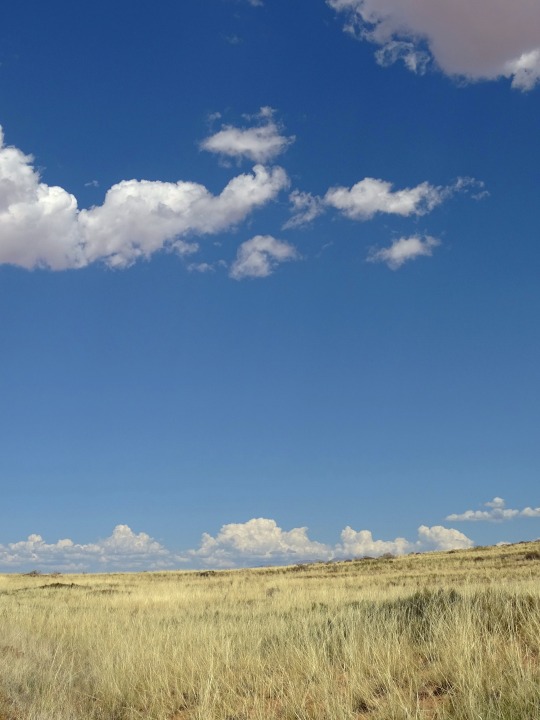
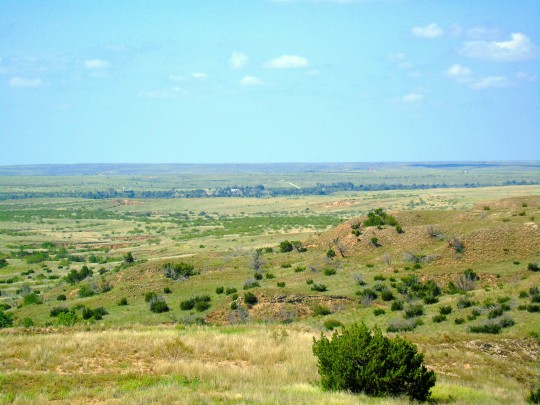
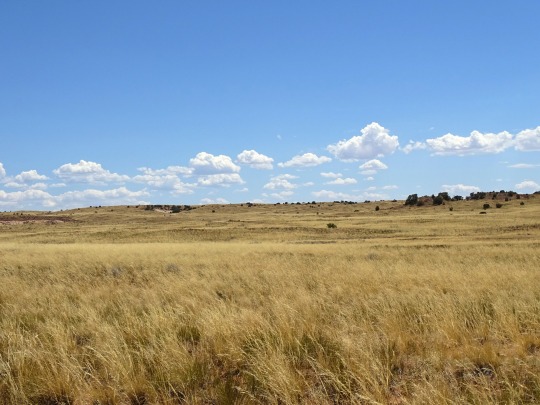


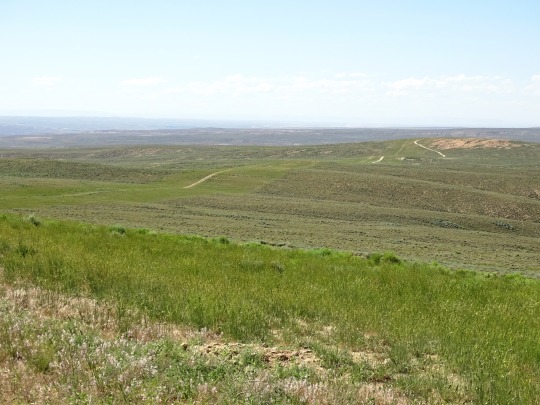
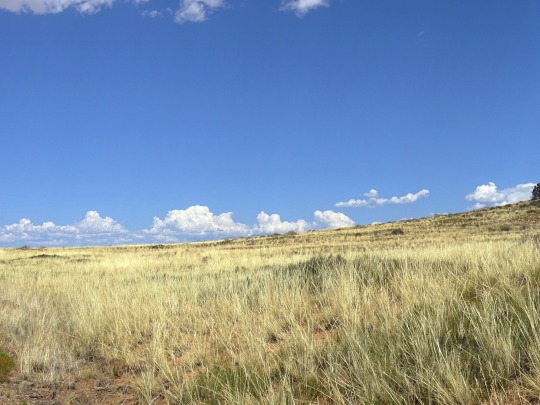



National Prairie Day
National Prairie Day, on June 3 this year, celebrates the beauty and ecological value of this often-overlooked ecosystem. Spanning more than a dozen American states and several Canadian provinces, the North American prairie is a vast grassland that offers more biodiversity and beauty than most people realize. With their endless, gently rolling plains and highly productive soils, prairies have been a valued location for farming and ranching for thousands of years. Today, only 1% of tallgrass prairie in the United States remains untouched by farming or development. National Prairie Day promotes the appreciation and conservation of America’s native prairies.
History of National Prairie Day
The United States is home to a dazzling array of geographies and environments. Some, like the towering redwoods of California or the majestic cascades of Niagara Falls, enjoy worldwide reputations as media darlings and tourist hotspots. Other ecosystems, like the humble prairie that covers much of the interior United States, receive fewer accolades but play crucially important roles in the development of the nation.
Defined as a flat grassland with a temperate climate and derived from the French for ‘meadow,’ ‘prairie’ has become almost synonymous with the expansion of the American frontier. Flanked by the Great Lakes and the grandiose Rocky Mountains, the North American prairie extends across 15% of the continent’s land area. Other examples of similar grasslands around the world include the pampas in Argentina, the Central Asian steppes, and the llanos of Venezuela.
There’s more to the prairie than meets the eye. In fact, tall grass prairies host the most biodiversity in the Midwest and provide a home for dozens of rare species of animals and plants, including bison, antelope, elk, wolves, and bears.
Native prairies face extinction as more and more land is converted to agricultural and ranching use. Due to its rich, fertile soil, prairie land is prized for agricultural use. Around the world, almost three-quarters of agricultural regions are located in grassland areas. With only 1% of tallgrass prairie in the U.S. remaining untouched, the American tallgrass prairie is now one of the most endangered ecosystems on the planet. The Missouri Prairie Foundation launched National Prairie Day in 2016 to raise awareness and appreciation for the nation’s grasslands. The organization seeks to protect and restore native grasslands by promoting responsible stewardship, supporting acquisition initiatives, and providing public education and outreach.
National Prairie Day timeline
6000 B.C. The Prairie Forms
The North American prairie forms roughly 8,000 years ago when receding glaciers give way to fertile sediment.
1800s The American Prairie Decimated
Throughout the 19th century, farmers and ranchers, excited about the rich potential of prairie soil, convert almost all of the American prairie to farmland and grazing land.
Early 1930s The Dust Bowl
The combination of years of mismanagement, the stock market crash, and drought conditions come to a head as thousands of families in Oklahoma, Texas, and other parts of the Midwest lose everything when their farms fail, driving them to California and elsewhere to seek work in more fertile fields.
2016 First National Prairie Day
The Missouri Prairie Foundation launches the National Prairie Day campaign to promote awareness and conservation of the vanishing ecosystem.
National Prairie Day FAQs
Why don't prairies have any trees?
The environment of the prairie, with its flat terrain, regular droughts, and frequent fires, is uniquely suited to grasses that don’t require a lot of rainfall or deep soil to thrive.
Why are prairies important?
The prairie provides an irreplaceable home for hundreds of plant and animal species, as well as exceedingly fertile soil for human agriculture and ranching. Prairie destruction has had catastrophic effects, like the Dust Bowl that decimated American farms in the 1930s. Prairies also contribute to the conservation of groundwater.
Why did the Dust Bowl happen?
The Dust Bowl disaster that swept the U.S. and Canada in the 1930s had several natural and man-made causes, including severe drought and a failure to properly manage farmland and conserve precious topsoil. A series of intense dust storms wiped out agriculture, eroded the soil, and left the land unable to produce crops.
National Prairie Day Activities
Learn about the prairie
Donate to a conservation group
Plan a visit to a famous prairie
Do a little research to learn about this important American ecosystem and the role it has played in the cultural and economic development of our country.
If you're concerned about the loss of the American prairie, donate to a grasslands conservation group to support their work.
Do you live near a prairie? Try finding the grassland nearest you and plan a visit.
5 Interesting Facts About Prairies
‘Prairie schooners’
Dogtown
Where the buffalo roam
Carbon hero
Rising from the ashes
During the 1800s, when Americans embarked on the long journey westward, their covered wagons were often referred to as ‘prairie schooners.’
Prairie dogs live in vast networks of underground burrows called ‘towns,’ which can cover hundreds of acres and house thousands of prairie dogs with complex social relationships.
When Europeans first arrived in North America, up to 60 million bison roamed the plains — by 1885, there were fewer than 600.
Prairies can help fight climate change — one acre of intact prairie can absorb about one ton of carbon each year.
On the prairie, wildfires can actually be a healthy thing — with more than 75% of their biomass underground, prairie plants are uniquely suited to surviving and thriving after a fire.
Why We Love National Prairie Day
The prairie often gets overlooked
Native grasslands are critically endangered
It reminds us of the diversity of America's ecosystems
It's not often we remember to celebrate grasslands, yet the prairie plays an important role in America's cultural past and environmental future.
With only 1% of America's native prairie remaining, it's more urgent than ever to conserve and protect this vital resource.
The United States has more environmental variety than almost any other country on earth. Celebrating each unique ecosystem reminds us to appreciate and protect all the beauty our country has to offer.
Source
#Colorado#South Dakota#Wyoming#Alberta#Saskatchewan#nature#flora#WickBeumee Wildlife Habitat Management Area#Custer State Park#Rock Springs#Pilot Butte Wild Horse Scenic Loop#Trans-Canada Highway#Texas#landscape#countryside#summer 2022#2019#original photography#wildflower#meadow#first Saturday in June#3 June 2023#National Prairie Day#NationalPrairieDay
60 notes
·
View notes
Text
Progg (Monster)

(Smoky Progg by @louivi)
(The flip side of the Mamuta, I simply HAD to do the Smoky Progg. I was a bit conflicted, whether or not to make the progg human sized or whether to maintain the pikmin scale, and I decided I'd keep it Mamuta sized. So this is a tiny undead fey that blights your lands in revenge for wrongdoings! I know PF fey don't technically have souls, but Rise of the Runelords features a ghost dryad and it's basically the foundation of Golarion canon, so.)
Progg are undead created by the sorrow and hatred of small, benevolent fey when killed in an unholy place. They are driven to blight the land they inhabit, killing plants, choking out livestock, and tormenting the peasantry. Progg have a knowledge of who they once were, but only distantly; whatever connections they made and emotions they felt as a fey are diminished to near nothingness. All a progg feels is an insatiable need to destroy life, especially plants. To this end, progg frequently target stores of seeds, flowers in bloom, and young sapling trees- a land blighted by a progg may not only lose this year’s harvest, but all future harvests if no help comes.
Progg, notably, have little desire to harm humanoids; they will defend themselves if threatened, but if there is a suitable target of young plant life to destroy, a progg will often focus its attention on moving there, even if it’s in danger of being destroyed itself. Good-hearted monster hunters know to sanctify such areas, as progg can not see nor enter such a place- although more unscrupulous adventurers may let the progg carry out its destructive mission in exchange for free hits.
A smoky black-green mass shambles forward, two red eyes staring dead ahead.
Misc- CR5 NE Tiny Undead (Incorporeal) HD6 Init:+7 Senses: Perception:+11 Lifesense 60ft, Darkvision 60ft Aura: Choking Smog (15ft, DC17)
Stats- Str:- Dex:16(+3) Con:- Int:10(+0) Wis:16(+3) Cha:19(+4) BAB:+4 Space:2.5ft Reach:0ft
Defense- HP:51(6d8+24) AC:14(+3 Dex, +1 Dodge) Fort:+2 Ref:+5 Will:+8 CMD:15 Immunity: Undead Resistances Weakness: Vulnerable to Plants Special Defenses: Channel Resistance +4, Incorporeal
Offense- Touch +9(1d8+4 Negative Energy, Curse of Withering) CMB:+2 Speed:20ft Special Attacks: Curse of Withering (DC17)
Feats- Dodge, Improved Initiative, Combat Casting
Skills- Intimidate +12, Knowledge (Nature) +5, Perception +11, Sense Motive +11
Spell-like Abilities- (Caster Level 6, Concentration +10, +4 bonus when in Combat)
Ghost Sound, Mage Hand /at-will
Diminish Plants, Steal Breath (DC16) 3/day
Ecology- Environment- Swamps, Urban Languages- Sylvan Organization- Solitary Treasure- None
Special Abilities-Aura of Choking Smog (Su)- A progg emits a cloud of necrotic, choking gas that withers and kills any living thing it touches. Nonevil creatures who enter or start their turn within the smog must make a DC17 Fort save or take 2d8 negative energy damage. Curse of Withering (Su)- A creature hit by a progg’s touch attack must make a DC17 Will save or be affected by the progg’s curse of withering. An afflicted creature receives half health from magical healing effects and cannot heal from resting. This curse cannot be dispelled; it requires Remove Curse or a similar effect. Vulnerable to Plants (Ex)- A progg, even in its warped state, still has some connection to the floral world. Living plant matter treats a progg as though it was corporeal; it is damaged normally from the natural attacks of Plant creatures and weapons made of living wood, and cannot pass through living plants. Any wooden structures or weapons not made of living wood affect the progg normally, however.
31 notes
·
View notes
Text
The ecological crisis must be recognized for what it is: a clear indication that the global North’s norms of production and consumption, which evolved with capitalism and have now become universal, can be maintained in their ecologically modernized form only at the cost of ever more violence, ecological destruction and human suffering, and, at that, in an ever-smaller part of the world. We now see an unprecedented accumulation of contradictions as a result of an authoritarian politics that is increasingly based on the exploitation of nature and on social inequality. The reproduction of society and its biophysical foundations can be guaranteed less and less by the capitalist growth imperative. We are living through a crisis of crisis management, a crisis of hegemony and the state.
The Imperial Mode of Living: Everyday Life and the Ecological Crisis of Capitalism
146 notes
·
View notes
Text
[T]he political philosophy underlying Westphalian, modern sovereignty [...], foundations of the modern state, [...] [formed] in relation to plantations. [...] [P]lantations [are] [...] laboratories to bring together environmental and labor dimensions [...], through racialized and coerced labor. [...] [T]he planters and managers who engineered the ordering and disciplining of these [...] [ecological] worlds also sustained [...] [p]lantations [by] [...] disciplining (and policing the boundaries of) humans and “nature” [...]. The durability and extensibility of plantations, as the central locus of antiblack violence and death, have been tracked most especially in the contemporary United States’ prison archipelago and segregated urban areas [...], [including] “skewed life chances, limited access to health [...], premature death, incarceration [...]”. [...]
Relations of dependence between planters and their laborers, sustained by a moral tie that indefinitely indebts the laborers to their master, are the main mechanisms reproducing the plantation system long after the abolition of slavery, and even after the cessation of monocrop cultivation.
The estate hierarchy survives in post-plantation subjectivities, being a major blueprint of socialization into work for generations and up to the present. [...] [Contemporary labor still involves] the policing of [...] activities, mobility and access to citizenship [...].
---
[There is] persistence - until the 1970s in most Caribbean and Indian-Ocean plantation societies, and even until today in Indian tea plantations [...] - of a system of remuneration based on subsistence wages [...]. Plantations have been viewed as displaying sovereign-like features of control and violence monopoly over land and subjects, through force as much as ideology [...]. [W]itness the plethora of references to “plantocracies” [...] ([...] sometimes re-christened “saccharocracies” in the Cuban and wider Caribbean context [...] [or] “sovereign sugar” in Hawai’i). [...]
[T]race the genealogy of contemporary sovereign institutions of terror, discipline and segregation starting from early modern plantation systems - just as genealogies of labor management and the broader organization of production [...] have been traced [...] linking different features of plantations to later economic enterprises, such as factories [...] or diamond mines [...] [,] chartered companies, free ports, dependencies, trusteeships - understood as "quasi-sovereign" forms [...].
---
[I]n fact, the relationships and arrangements obtaining in the space of the plantation may be analogous to, mirrors or pre-figurations of, or substitutes for the power and grip of the modern state as the locus of legitimate sovereignty. [...] [T]he paternalistic and violent relations obtaining in the heyday of different plantations (in the United States and Brazil [...]) appear as the building block and the mirror of national-imperial sovereignties. [...]
[I]n the eighteenth-century [United States] context [...], the founding fathers of the nascent liberal democracy were at the same time prominent planters [...]. Planters’ preoccupations with their reputation, as a mirror of their overseers’ alleged skills and moral virtue, can thus be read as a metonymy or index of their alleged qualities as state leaders. Across public and private management, paternalism in this context appears as a core feature of statehood [...]. Similarly, [...] in the nineteenth century plantations were the foundation of the newly independent Brazilian empire. [...] [I]n the case of Hawai’i [...], the mid-nineteenth-century institution of fee-title property and contract labor, facilitated by the concomitant establishment of common-law courts (later administered by the planter elite), paved the way to the establishment of sugar plantations on the archipelago [...].
---
[T]he control of movement, foundational to modern sovereign claims, has in the plantation one of its original experimental grounds: [...] the demand for plantation labor in the wake of slavery abolition in the British colonies (1834) occasion[ed] the birth of the indenture system as the origin of sovereign control on mobility, pointing to the colonial genealogy of the modern state [...].
The regulation of slaves’ mobility also represented a laboratory for the generalization of [refugee, immigrant, labor] migration regulation in subsequent epochs [up to and including today] [...] [subjugating] generally racialized and criminalized subjects [...]. [P]lantations appear as a sovereign-making machine, a workshop in (or against) which tools of both domination and resistance are forged [...].
---
All text above by: Irene Peano, Marta Macedo, and Colette Le Petitcorps. "Introduction: Viewing Plantations at the Intersection of Political Ecologies and Multiple Space-Times". Global Plantations in the Modern World: Sovereignties, Ecologies, Afterlives (edited by Petitcrops, Macedo, and Peano). Published 2023. [Bold emphasis and some paragraph breaks/contractions added by me. Presented here for criticism, teaching, commentary purposes.]
#abolition#ecology#multispecies#landscape#imperial#indigenous#colonial#tidalectics#archipelagic thinking#plantations#ecologies#carceral geography#caribbean
42 notes
·
View notes
Text
One of the most important books of the past 15 years is Capitalist Realism by Mark Fisher. The basic idea of it is that it describes the pervasive nature of capitalism. It seeps into our hopes, dreams, and thoughts, shaping how we currently understand the world and imagine what the world can be. It’s some spooky shit. Even so, the scarier thing in my mind is hierarchical realism. To me, that feels even more fundamental to our shared worldview than capitalism. Capitalism exists atop (or within) the hierarchy. Capitalism is a relationship of hierarchy. Instead of the top of the pyramid serving the bottom-most elements like in other complex systems (think of how the sun emits energy, plants photosynthesize that energy and animals eat those plants) the base of the pyramid toils for the sake of the top. In nature, the ant colony doesn’t “serve” the queen like we tend to think. It protects the queen because that means that the population can continue to exist. There are no orders being given. The colony efficiently self-organizes into emergent forms that efficiently solve problems. Simple sets of abilities and impulses combine to create elegant solutions.
In our social systems, with capitalism being one of the clearest examples, our hierarchies exist for the opposite reason. We protect kings not because it benefits us, but because it benefits them, at our expense. They then socially engineer consent and mindsets to reinforce their position. This impoverishes our imaginations and prevents us from seeing social possibilities outside of domination and coercion. This is the negation of autonomy and abolition.
This arrangement seems to be taken for granted in most folks’ minds. In our social, political, and economic realms, there is a tacit assumption that those relationships have to be vertically integrated. Orders have to come from the queen, carried out by the colony.
Unsurprisingly, this is a very undemocratic and un-egalitarian way to organize society, but it’s been the dominating mode of organizing at least since civilization has been a thing. This is because it allows for power to be unevenly distributed, and for that distribution to be reinforced over time. Authority is king (and kings are authority). Human value isn’t intrinsic. It is proportional to class position. This also makes it difficult to change social relationships. This arrangement stifles our progression as a species, and our ability to be in community, period. Whether that’s connecting with other humans or other natural beings, this foundational relationship of domination is very toxic for us.
For us to break free from this, we have to go in a different direction. We have to reorganize society using bottom-up approaches so that we can not only have all of the benefits of being in society but are able to provide those benefits for everyone, sustainably. By taking a horizontal orientation, we can take steps to model our societies off of the ecosystems that they reside in, making them resilient, adaptable, and ecological.
Understand that we don’t need a pyramidal structure to run society. Holding all of the decision-making power at the grassroots level allows for autonomy to flourish.
If you take nothing else from this, understand that realism does not equal reality. The pervasive nature of something, especially something man-made, does not mean that it was always this way, and it always has to be this way. Know that we can do something different and really reach the ideals of equality and freedom. We just have to be willing to put in the work.
54 notes
·
View notes
Note
hey i just wanted to comment on your recent therian post you made and uhm, bestie that’s a bizarre take imo lmao
first of all to say that being therian/nonhuman is a fetish?? and not an actual belief system is uhm?? i could point you in the direction of 100 therians that could tell you about their spiritual beliefs and how it’s tied to their therianthropy and how deep it runs for them, myself included. a good portion of them also believe in past lives and reincarnation. plus not all therians are spiritual, some are also psychological.
and the “lack of respect for animals” is also strange to me. folks in this community do so much research and reading on their kintypes and the folks that own tails or pelts always preach to make sure and double check that any animal product like that is from a ethical seller and not a fur farm. respect for animals and nature is quite literally the foundation for this community.
you said twice that you didn’t know much about the community and it clearly shows and you said some strange things and i just wanted to point it out- maybe do more of a deep dive into things of this matter before making bizarre takes 🫶
I'm sorry, I didn’t mean to be offensive. As I said, I don’t know much about it, so you can message me privately to explain more if I’m wrong. 🌸✌️ However, I repeat, based on what I’ve seen, my opinion remains the same and doesn’t change.
Now, from a biological standpoint, the claims made by the Therian community that humans can somehow spiritually or psychologically be non-human animals are not only misguided, they completely disregard basic evolutionary biology. Humans are Homo sapiens, not wolves, not tigers, not any other animal. The notion that a person can "identify" as an animal species has no scientific basis—none. Our cognitive abilities may allow us to connect with animals emotionally, but this does not grant us the ability to cross species lines. It's a psychological construct at best, but biologically, it’s simply impossible. Any attempt to blur these boundaries is a fundamental misunderstanding of nature itself.
Let’s talk about Theria—the real mammals. These are creatures that have evolved over millions of years, with specific biological adaptations that define them as marsupials or placental mammals. Therians might like to romanticize themselves as having some special connection to these animals, but frankly, this reduces these complex creatures to mere symbols for human identity crises. True respect for these animals means appreciating their place in the natural order, not claiming some fantastical connection based on vague feelings. To suggest that a human can "become" one of them—without acknowledging the biological and ecological roles these animals play—comes off as both absurd and disrespectful.
And let’s not ignore the cultural appropriation at play here. Indigenous cultures and ancient civilizations have had deep, authentic spiritual relationships with animals for millennia, rooted in folklore and religious practices that honor the natural world. To co-opt these sacred traditions without understanding their context or depth, and then apply them to personal identity politics, is not just disrespectful, it’s offensive. These cultures have always valued nature for what it is, not as a canvas for individual fantasy. By claiming to "be" animals, Therianism risks distorting and trivializing these deep cultural ties to the natural world.
So in the end, for me, this is just a subculture that I don’t think would survive without TikTok or other social media. I may have been blunt, and I’m sorry, but coming from a scientific background and from a millennia-old society that lives in harmony with animals (I literally have wolves and bears in the forest behind my house), I can’t help but notice how superficial this community is. (Again, I’ve tried to dig deeper and understand it ;)
I urge you, as I do, to spend entire days immersed in the mountains and forests, with nothing but a pair of binoculars, quietly tucked into the hollow of an old beech tree, observing these magnificent creatures as they truly are—each with their own unique and unrepeatable nature. I invite you to sleep beneath the sweeping branches of a chestnut tree or at the roots of a larch ablaze with autumn colors, only to be stirred awake at dawn by the bark of the deer. Feel the pulse of the earth beneath you, breathe in the crisp air, and listen to the whispers of the wild. Live the real, raw beauty of nature before you feel the need to invent another version of it.
#spiritualgrowth#spiritual journey#spirituality#spiritual awakening#religion#folklore#nature core#cottagecore girl#italian alps#mountains#christian witch#cottage witch#witchcraft#witchblr#witches#witch community#wicca#wiccan#pagan wicca#wiccablr#christian girl#christian living#christian faith#indigenous#native american#shinto#shinrin yoku#shintoism#buddism
4 notes
·
View notes
Text
Spy's Spec-Bio Essentials
I honestly didn't mean to write a full-on essay, but I couldn't help myself -I love specbio, and the recent revival of interest in it makes me very happy. If you wanna just get right to the meat: normal links are highlighted blue, YouTube links are highlighted red.
Speculative biology has its roots as far back as Pliny the Elder and his Natural History, though most consider H.G. Wells to be the true grandfather of the genre with works such as War of the Worlds, The Time Machine, and Man of the Year Million. However, any speculative biologist worth their salt credits Dougal Dixon as the father of specbio as we know it today –especially since he is the man who coined the term! Dixon's books After Man, Man After Man, and The New Dinosaurs are considered the foundational works of modern specbio. So too is Wayne Barlowe's book Expedition.
While the original printings of these books are very expensive to acquire, After Man recently received a Kindle version, and Expedition has a very good documentary adaptation available in totality on YouTube. Another important work of early speculative biology was the Discovery Channel limited series The Future Is Wild, a documentary show exploring the possible futures of life on Earth in several million years' time.
With the rise of the internet, people interested in speculative biology –those few and far between– could share their thoughts and amateur works with each other. Online specbio hit its first height around the mid-aughts to early tens, featuring many notable works that were very influential to me personally when I joined the scene circa 2014. Unfortunately, right around when I joined there was a notable "mass extinction" –many of the more active and prominent figures of the specbio community left the web behind for various reasons, and thus the golden age ended.
In recent years, partially thanks to certain YouTube video essays on the classic projects, interest in speculative biology seems to have increased dramatically! I've taken to calling the current era the "specbio renaissance," and it makes me so happy to see new, younger people interested in this unique facet of creativity. In light of this I've created this master post of my personal recommendations of essential specbio works for new "speccers" to enjoy!
The specbio community has congregated on forums for decades. I personally joined the community via DeviantArt right around when the old ZetaBoards forum underwent a massive host shift and never participated on the forum all that much, but fortunately the old Speculative Evolution Forum is still up and still active!
For those who'd prefer a simpler way to keep up with current events in the specbio community, Astrovitae is a free e-magazine dedicated to contemporary spec. A product of the recent specbio renaissance, Astrovitae only has a handful of issues thus far but is already becoming a staple publication in the field.
I made this post to provide what I think is key information and important resources, but the SpecBio Wiki is a far more thorough companion to your journey into the world of speculative biology. As always, though: beware ye old Wiki Rabbit Hole!
Biblaridion's Alien Biospheres video series is an excellent entry point for anyone looking to learn the basics of specbio. It's a demo xenobiology project, with a heavy focus on the scientific concepts used in building up the world and its ecology.
Curious Archive's Alien Worlds video series is an excellent collection of bite-size examinations of various specbio projects, including several on this list!
Nemo Ramjet (C. M. Kösemen)'s Life on Snaiad is universally considered a classic work of speculative biology, started in the early days of the golden age of internet specbio. Snaiad is an alien planet, in its early days of human habitation, filled with strange lifeforms bearing two "heads."
Kösemen's other well-known classic work is Alltomorrows, a short ebook exploring hundreds of millions of years' worth of possible human evolution. Readers, be advised: this work contains extensive body horror and discussion of human extinction, both circumstantial and deliberate.
Sagan IV, originally created by Hydromancerx, is one of the oldest and most extensive specbio projects. Started as a simple artistic exercise on a forum in 2006, Sagan IV has evolved into a large, highly collaborative vision of an alien world inspired by the works of Carl Sagan. It is still ongoing today, and you can participate in their regular contests and activities!
Gert van Dijk's Furaha is another of the well-known classic specbio projects, and one of the few from the golden age that is still fully active. Furaha itself is an alien world orbiting Nu Phoenicis which harbors a fascinating native biosphere, built upon carefully-researched biomechanics. The site itself is laid out much like an encyclopedia, and the accompanying blog is a treasure trove of specbio know-how and community history!
Sunrise on Ilion, a xenobiology project by @supermalmoworld, is a personal favorite of mine. Ilion is a planet tidally locked to a red dwarf star, and its endemic lifeforms often challenge our expectations for Earth-like ecology. The website boasts extremely detailed information on the setting and its inhabitants, as well as in-universe articles and logs of the various human expeditions to this fascinating world. The project is still active on a very sporadic basis, at least as per blog entries.
Nereus is a xenobiology project created by Evan Black; another reasonably well-known golden age work but one that is unfortunately no longer active. The world of Nereus, orbiting the star Achird, teems with life unfamiliar to the humans which seek to adopt it as their home. Like many specbio projects it adopts a documentarian style, but there are plenty of nuggets of story tucked in the articles.
Serina is a contemporary speculative evolution project created by the legendary Sheather; it is what I would consider the holotype of the "seed-world" branch of specbio. Serina is a planet populated only by the descendants of the domestic canary (and a few other organisms like guppies, snails, ants, sunflowers, bamboo, algae, etc). The project digs deeply into the various unique niches of the world and the organisms that evolve to fill them, and in doing so mixes nature-documentarian style with some of the most compelling and emotionally engaging storytelling I have read in years.
These are just what I think are the essentials. There are numerous other fantastic projects, both contemporary and from years ago, that I would highly suggest investigating! Contemporary honorable mentions that personally inspire me include @alexriesart's birrin, @iguanodont's birgs, @jayrockin's Runaway to the Stars, Christian Cline's Teeming Universe, Keenan Taylor's Kaimere, and my friend Mičkin's Temere!
#sorry about the @ mentions folks I just think your works are cool and deserved inclusion!#edit: thank you to the anon who reminded me about Sagan 4#spy has thoughts#long post#please don't mind the organizing tags here#speculative biology#speculative evolution#speculative ecology#xenobiology#specbio#spec bio#specevo#spec evo#dougal dixon#after man#man after man#wayne barlowe#darwin iv#the future is wild#snaiad#all tomorrows#Sagan 4#Furaha#Ilion#Nereus#Serina
131 notes
·
View notes